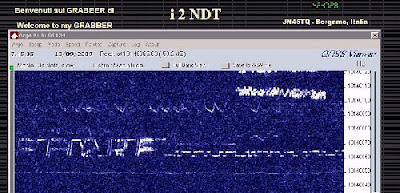While cleaning up my harddisk I ran into some pictures from a QRSS experiment I did in 2009/2010. QRS means " lower your speed "; with QRSS it is meant that really slow modulation methods are used.
Here you see the screenshot of the grabber of I2NDT who received my 500 mW signal on 10.140 MHz in Borgema, Italy, QTH locator JN45tq.
You can see my callsign in the screen followed by morsecode.
I recall I made a simple X-tal oscillator on 10.140 MHz. The X-tal oscillator was followed by a simple ATU and that was my QRSS beacon. The signal from the oscillator was frequency modulated with a varicap connected to the X-tal. A variable DC voltage was applied to the varicap. This DC voltage was created by a PIC16F628A which contained the code for my callsign and waveform that contained the CW code.
A picture from a UK grabber in JO01ho from G6AVK shows the 30m 500mW signal easily crossed the North Sea.
This is the grabber from PA1GSJ, Joachim, on short distance from my QTH (Iess than 15 km). This time an experiment with 1250 mW. Modulation performed by the program SpecLab. Frequency stability is poor as you can see by the sloped text. Here you can get an idea of the speed of the signal; the screen covers an elapsed time of more than 15 minutes.
At that time I was amazed what was possible with QRP power (and less). Now, with the presence of WSPR (Weak Signal Propagation Reporter or "Whisper") and smart modes like JT-9, I learned that worldwide communications can be established with (far) less than 5 Watts.


No comments:
Post a Comment